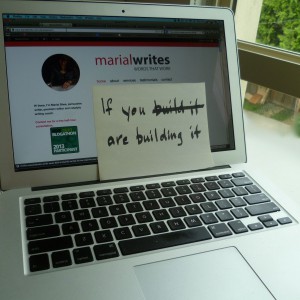Talking back to books.
Blogging My Way Out of Fear
 True confession: I, Marial Shea, am afraid of my own website. There, I’ve said it. I launched MarialWrites in February and, since then, I’ve published a mere three blog posts. I thought if I built the site, I might magically become a blogger. Call it the “if you build it, they will come” fallacy. I figured if I built the site, at the very least I would show up.
True confession: I, Marial Shea, am afraid of my own website. There, I’ve said it. I launched MarialWrites in February and, since then, I’ve published a mere three blog posts. I thought if I built the site, I might magically become a blogger. Call it the “if you build it, they will come” fallacy. I figured if I built the site, at the very least I would show up.
Now I’m realizing I was one tiny grammatical adjustment away from the truth: just change the tense of the verb “build” to present continuous.
If you are building it, they will come. A blog isn’t something you build, it’s something you are building. Blogging happens in the present continuous.
Joining the WordCount Blogathon
Today I began to exercise my fear-cramped blogging muscles by joining the 2013 WordCount Blogathon. The fabulous Michelle Rafter started this event in 2008. Every year it brings people together to become better bloggers by writing a post a day for the month of June. That’s 30 posts in a row, yikes!
Talk about present continuous.
I’m joining partly to get in the habit of blogging. But an equal draw is Michelle herself. I’d follow her anywhere. Her blog WordCount: Freelancing in the Digital Age ranks on many top-ten blog lists, and for good reason: Michelle delivers consistent, quality coverage of “the craft of writing, running a freelance business and the latest tech tools for writers.” No matter how work-swamped or web-weary I am, I always read her posts. If you want a taste, try WordCount’s top thirty posts for 2012.
Even though I’ve been writing for years, I’ve got a lot to learn as a blogger. Where do I fit in the digital world? Where do I want to fit? How do I dive into the hidden depths of things, as I love to do, and still swim back up to the surface with information readers can actually use?
I’m going to find out by doing what I’ve always done: write.
Present continuous: I am blogging.
Stalking the Wild Voice
“Stellaaaaaa!”
Marlon Brando first played Stanley Kowalski in 1947 in a stage version of Tennessee Williams’ A Streetcare Named Desire. Then, in Kazan’s 1951 film version, Brando let rip one of the most famous hollers in screen history.
Brando’s scream is celebrated in New Orleans this weekend in the Stanley and Stella Shouting Contest, part of the annual Tennessee Williams/New Orleans Literary Festival.
A young actor and writer named Elena Passarello has written a quirky book of essays about the human voice called Let Me Clear My Throat. It so happens that, among Passarello’s many talents, she won the 2011 Stanley and Stella Shouting Contest. Here’s a youtube video of Passarello’s final round, filmed on an iPhone by an audience member:
After studying herself in the youtube video, Passarello wrote a play-by-play analysis of her own winning screams (from her essay “Harpy”):
I am just a faraway outline of myself … In between the first and second screams, I gasp, and I just keep breathing in, trying to extend the last vowel of “Stella!” through the inhale. The crowd howls at this. After the second “Stella!” I shake my head vigorously, like the scream is a whiskey shot that burns as I swallow it. I have no idea where any of those ideas came from.
The third scream, I think, is the scream that won it. You can hear me lose a battle in my throat. You do not have to assume that I will be mute for days afterward; you know it … I did not tell myself to make this hurt, but there I am, punching lower and lower into myself to see what comes up.
This reminds me of Annie Dillard’s much-quoted exhortation (from The Writing Life) on how to write:
… spend it all, shoot it, play it, lose it, all, right away, every time. Do not hoard what seems good for a later place in the book, or for another book; give it, give it all, give it now.
I keep going back to watch that video clip of Passarello spending everything’s she’s got, givin’ ‘er, reaching down and finding more. I love her for her balls-out full-throttle woman-roar — for striding out on stage and stripping from the inside out. She’s my proxy, this fiery clown-warrior, purging me of all the times I’ve shoved my own fist down my throat to silence myself.
In her essays, Passarello tells stories about the human vocal chords — how and why they do what they do. She explores the sound of the original rebel yell by Stonewall Jackson’s Union soldiers, Sinatra’s meticulous singing technique, the nuances of the Pittsburgh accent, Howard Dean’s political death scream, and the in-joke among movie sound-effect nerds known as the Wilhelm Scream.
And, fittingly enough, the book even has a soundtrack. Go to the author’s website and listen to CJ Bargamian’s moody tunes.
Standing Up on the Job, Part 2
 New research on the dangers of sitting
New research on the dangers of sitting
We sit too much. Common sense tells us this and now research confirms it.
If you think you can make up for all the sitting you do with regular exercise, think again. Even if you’re getting the recommended 30 or 40 minutes of exercise each day, a recent small study shows that it’s negated by hours spent parked on your keister.
And this study found that sitting causes us to put on a specific kind of fat around our hearts that’s dangerous because it’s strongly related to heart disease.
Glycemic response in overweight people was measured in this new study, which showed that glucose and insulin levels increased by 20 percent in those subjects who sat for two hours after the test meal instead of engaging in moderate activity.
A recent Australian study of over 63,000 men examined links between sitting and chronic disease, comparing men who sat less than four hours a day with those who sat from four to six hours, six to eight, and more than eight hours. Significantly more men over the four-hour mark reported having not only diabetes, but also cancer, heart disease and high blood pressure, and the risk increased as the hours of sitting increased.
Idle muscle has negative effects on fat and cholesterol metabolism. But here’s the good news: standing can double your metabolic rate, with no additional exercise.
What about treadmill desks?
Some people turbocharge their standing desk by adding a treadmill. Great idea, right?
Well, maybe not. My go-to movement expert, Katy Bowman, warns in this post that the mechanics of movement on a treadmill are more like falling than walking:
[Treadmills] often contribute to spine, hip, and knee problems. Because the belt moves backward, our feet meet little or no resistance when they push off. This requires us to lift our legs out in front of us (holy psoas, Batman!) and then fall forward. The hips, knees, and feet, unfortunately, then have to provide the cushioning for the crash landing.
Build your own standing desk
You can purchase a purpose-built standing desk, but why not jerry-rig a temporary setup first to see if you like it? I reconfigured the desk I had by fully extending the legs and piling my keyboard and monitor up on piles of books (see the photo in Part 1).
Here are some other ideas you can cobble together on the cheap:
Treadmill Desk Diary — I know, I advise against treadmills, but this delightfully geeky site has tons of useful info.
“Hack a Standing Desk from IKEA”
More inspiration to get you standing
“Office Workers Beware: Sitting Time Associated With Increased Risk of Chronic Diseases”
Standing Up on the Job, Part 1

After years of working as a freelance writer, I was starting to worry that I hated my job. I’d spot the mail carrier walking by and fantasize about applying to the post office. My whole body was screaming “get me out of here!” and I didn’t know why.
Then I stumbled across some recent research showing that sitting down on the job puts us at risk for all kinds of negative outcomes (like death, for example — see Part 2 for details).
Turns out I didn’t hate my work, I just hated sitting at my desk. Time to experiment. I extended the legs of my Ikea Galant desk to maximum height, propped my computer, keyboard and mouse on piles of books and launched my own study of standing on the job.
Results were instant and remarkable. Right away, I felt light and loose, mobile and engaged, instead of compressed, rigid and disembodied. I noticed that I was constantly in subtle motion, swaying from side to side, twisting, shifting my weight from one leg to the other, bending and straightening my knees. Standing, I had become a body in motion, whereas sitting I am a force resistant to motion.
Mine is not an original observation. Newton accounted for it in his first law of motion: an object at rest stays at rest and an object in motion stays in motion. Standing places me firmly in motion, enlivening my whole working day.
As a bonus, within a week and a half of switching from sitting to standing, I found that my legs had grown noticeably stronger. No exercise I’ve ever done has strengthened me so quickly – and without any special equipment or dedicated exercise time.
Sitting at my desk, I’m a talking head floating in space. Standing, I’m firmly rooted, engaged, ready for action. Apologies for sounding evangelical, but I’ve never made a change with such immediate and positive results.
In Part 2, I’ll review the research on the health risks of sitting and suggest some ways you can set up your own standing desk.
Blog posts
No Results Found
The page you requested could not be found. Try refining your search, or use the navigation above to locate the post.

